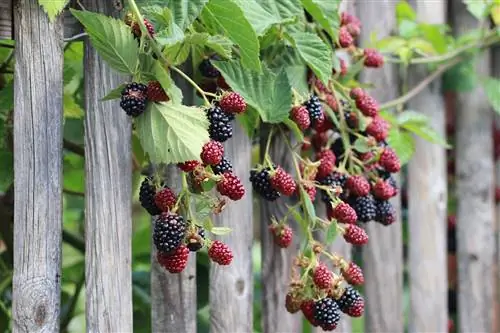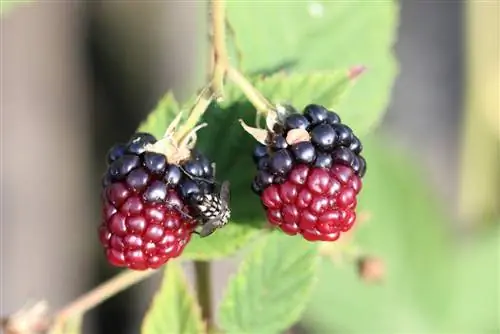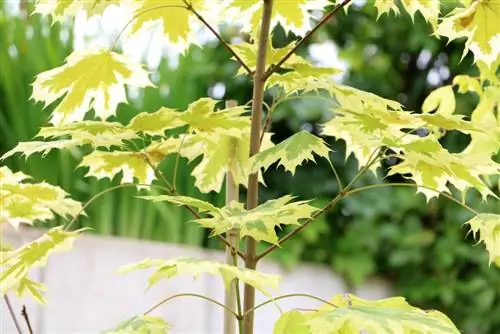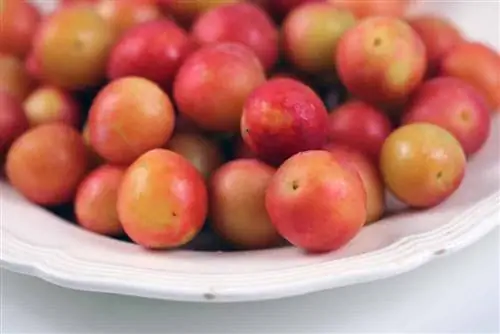- Author admin [email protected].
- Public 2023-12-17 03:39.
- Last modified 2025-01-24 12:45.
The knowledgeable gardener cuts his blackberries every year. Reward for the effort: large and sweet fruits. Cutting follows clear instructions, as growth characteristics leave little scope for cutting and timing.
Plant cutting
Blackberries are ideally planted in spring, around March or April. The first pruning takes place immediately after planting. All tendrils are cut back to 30 to 40 cm, each just above a leaf or shoot bud. Buds close to the ground should be covered with soil about 5 cm high. Later in spring the best rods are selected and the remaining ones are removed close to the ground.2-3 canes should remain on strong-growing varieties and 5 to 10 canes on weak-growing varieties.
Training pruning for espalier
Blackberry plants have two-year-old canes that bear fruit in the current year and newly sprouted canes that will only bear fruit in the following year. When blending, the two types must be clearly distinguished. Otherwise, young fruit shoots could be accidentally removed or useless harvested canes left standing. Training on the trellis helps to keep an overview because the rods are tied to it alternately.
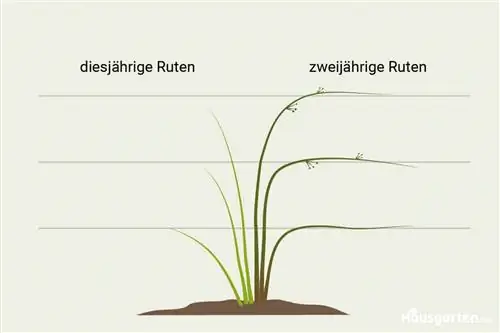
- erect a wire trellis before planting
- for strong-growing varieties 6 m wide
- for less expansive varieties 3-4 m wide
- tension three wires at 50, 100 and 150 cm height
- Plant the plant in the middle of the trellis
- tie all selected rods horizontally or in a fan shape
- only use one side of the wire trellis
- the following year, tie the new canes on the other side of the trellis
- this year's and two-year-old rods are clearly separated spatially
- tying made subsequent mixing impossible
Tip:
Before planting, find out whether the blackberry variety you have chosen forms runners. The thorny varieties are particularly known for this. If this is the case, you should definitely build a root barrier about 30 cm deep for the shallow-rooted plant. The easiest way to do this is to line the planting pit with pond liner.
Instructions for a maintenance cut
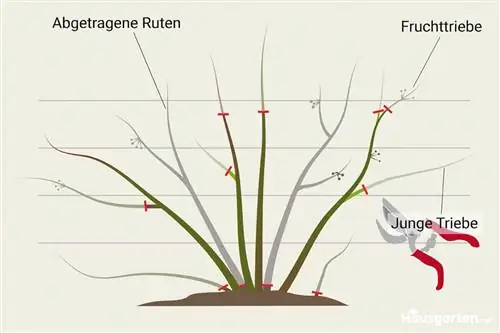
The worn canes must be cut annually and removed from the trellis wire. At the same time, new fruit canes must be cared for and tied up with appropriate pruning measures. In a very mild region, pruning can be done in the fall after harvest. Unless the canes have been arranged alternately on a trellis, they are easy to distinguish at this point. In a rather harsh region, you should definitely wait until February or March before cutting. The blackberry sprouts happily after cutting back. It is not certain whether the new growth will be able to harden well until winter.
- Wait for an ideal day. The sky should be overcast and the temperature should be above freezing.
- Cut back all worn and dead canes from the previous year close to the ground.
- Cut back side shoots on last year's tendrils that form the new fruit shoots to two to three buds.
Tip:
When pruning blackberries, you should always place the scissors about 0.5 to 1 cm above a bud that is facing outwards. A bud is easy to recognize because it looks like a slight thickening on the shoot.
Instructions for a column cut
In a small garden, training on a trellis is not possible due to space constraints. An upright column shape, on the other hand, is easy to create. It even allows you to plant it in a pot on the balcony. However, weak-growing, thornless varieties are mainly suitable for this type of training.
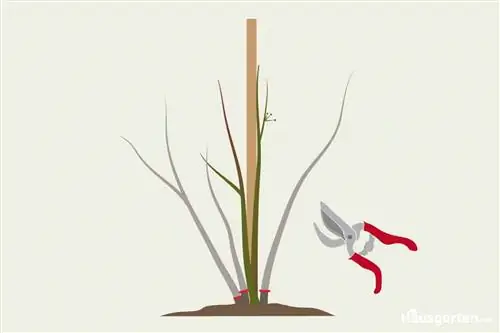
Here are the instructions for the column cut:
- After planting, tie the two strongest shoots to a support post. Since blackberry vines are not very heavy, 1-2 strong, long bamboo sticks, which are inserted deep into the ground, are sufficient.
- Cut off the remaining shoots at ground level.
- As the year progresses, you guide the elongated shoots up the support post.
- Perform maintenance pruning every February.
- Cut off worn ground shoots.
- Attach one or two new rods to the support post, cut the rest off at the base.
- Cut side shoots back to 1-2 buds.
- Short the main rib to the desired length.
Tip:
If possible, cut back harvested canes immediately after harvest. Leave a stump 10-15 long. In practice it has been shown that new tendrils sprout from sleeping eyes in spring.
Summer cut
If you only cut strong-growing varieties once a year, you are not getting the best out of the berry bushes. They also tend to form a confusing thicket over the course of the summer. The reason for this are numerous stingy shoots that form on the sides of the main shoots. They do not flower or fruit, and they also compete with the fruit shoots for water and nutrients. If the canes are not tied alternately, the stinging shoots will also cast shadows on fruit shoots with their lush foliage. The fruits cannot then ripen optimally or even become moldy because rain moisture cannot evaporate quickly.
- carry out a summer cut in July
- select and tie suitable rods for this year
- remove excess tendrils
- Cut back side shoots to 1-2 buds
Radical cut
If a blackberry plant is cared for annually according to instructions, there will be no need for radical pruning throughout its lifespan. If cutting has been missed, what was missed can be corrected by looking closely. However, things are different after years of neglect. If you can no longer distinguish between this year's and old rods in the tangle of rods, you should cut off all of the rods. After new growth, regular, orderly pruning care can then be resumed. Of course, such a radical cut is associated with a crop failure in the cutting year.
A must: suitable cutting tool
It's not just cutting errors that can endanger he althy growth and a bountiful harvest. If you cut your blackberries with unclean or blunt scissors, you will produce contaminated or frayed interfaces. This makes blackberries particularly susceptible to diseases and pests. Before each cut, the blades must be sharpened and disinfected with a suitable agent, for example spirit.
Tip:
A weak young cane that has to be cut off in spring is too good for the compost heap. If the shoot is cut cleanly and smoothly into pieces about 30 cm long and placed in loose, nutrient-rich soil, new blackberry bushes will grow from them in no time.

